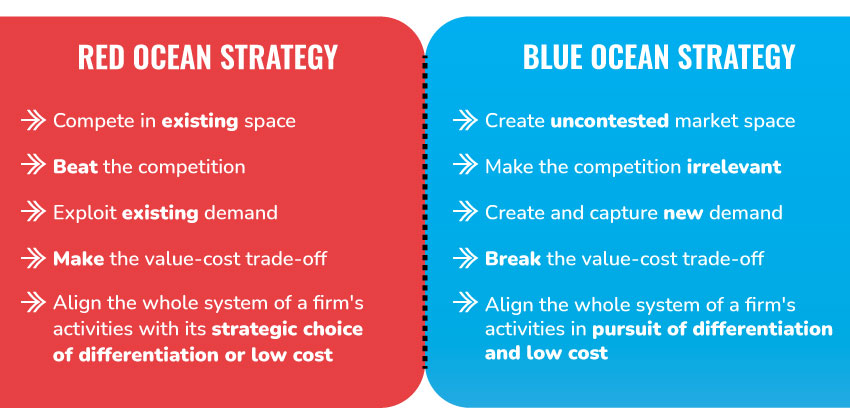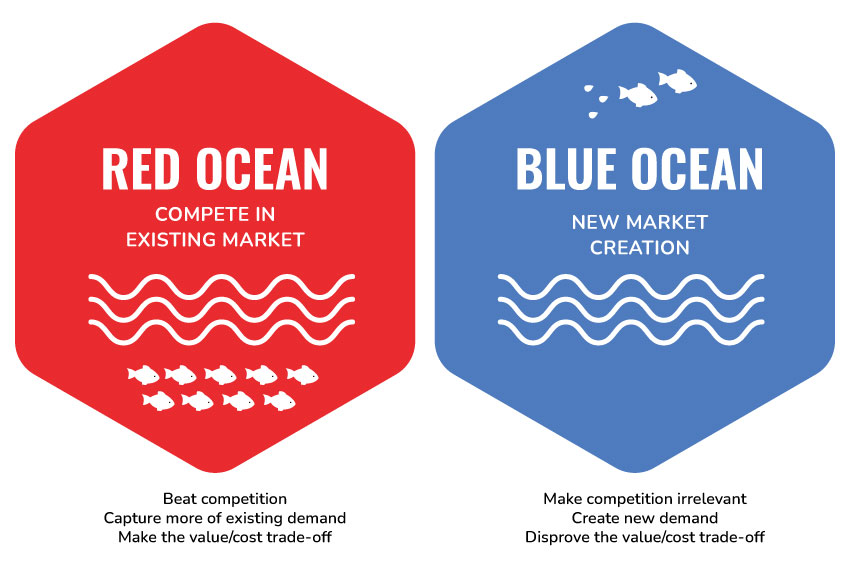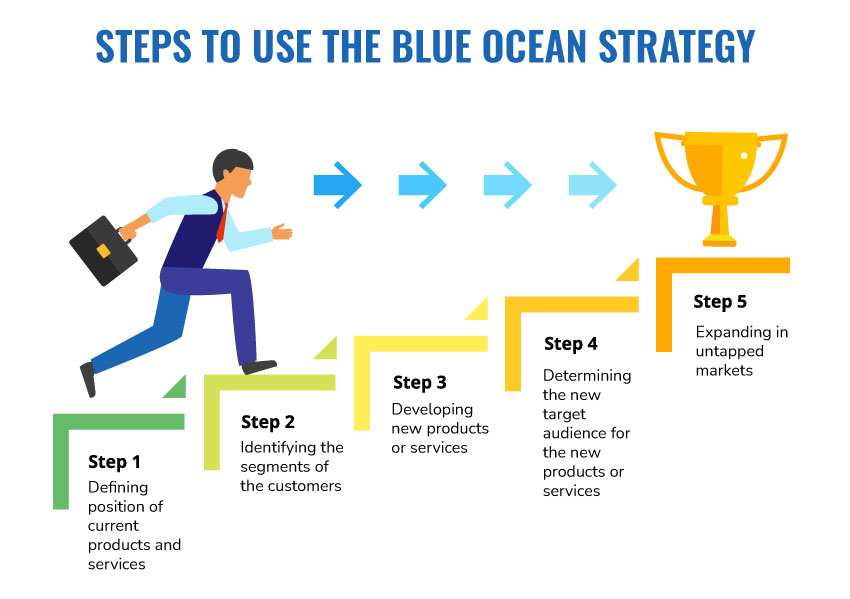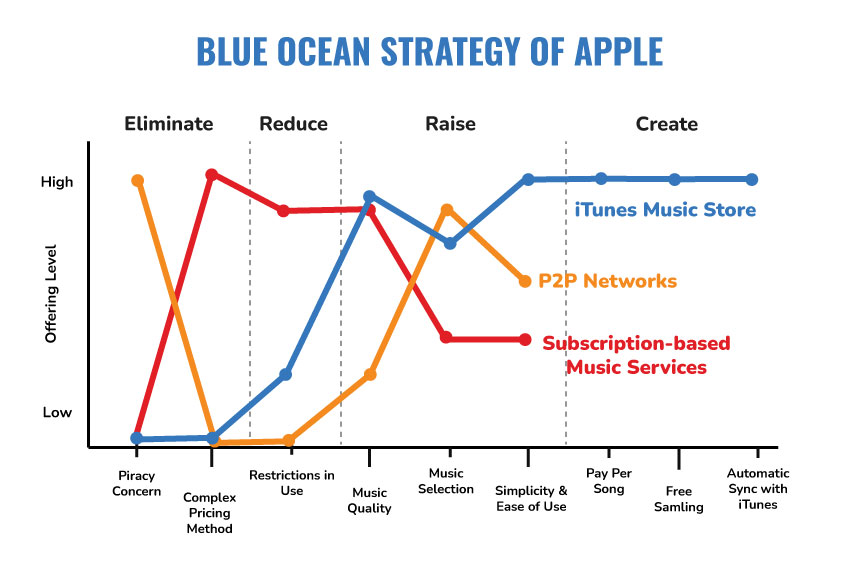Table of Content
Introduction to Blue Ocean Strategy
In today’s business world, most business organizations operate in an intensely competitive environment and focus on improving their competitive position in the industry. You must also be aware of the fact that when the business organizations operate in a highly competitive business world, then there is a very high possibility that the organization will face pricing pressures and its operations may also come under threat. This situation is known as the Red Ocean. However, the Blue Ocean Strategy is just opposite to the Red Ocean Strategy.
When there is a limited chance of the growth of the organization, the business firm may try to find new products and services or businesses where it can enjoy the uncontested market. Blue Ocean Strategy is a strategic planning model which supports that the organization should not only try to compete in the existing market but should also find new markets to explore the untapped markets and attain strong profitability. The Blue Ocean Strategy can be used by the organization where there is no or very little competition. This strategy revolves around the process of searching for the business area in which very few businesses operate and there is no pricing pressure. The Blue Ocean exists when there is a possibility of higher profits due to the prevalence of no or irrelevant competition.

The need for the Blue Ocean Strategy Model
The Blue Ocean Strategy is an important strategic planning tool that can help the organization to determine the strategies that can be adopted to improve the organization’s performance.

The major reasons for using the Blue Ocean Strategy are discussed as follows-
- The main reason to use the Blue Ocean Strategy is to capture new markets and earn higher profits by creating new demand. The organization can also use the Blue Ocean Strategy to make the competition irrelevant in the industry by launching up the products with new features. Not just this, the unique product features can also help to increase organizational profitability as the firm can charge steep prices for the unique products and services.
- The other main reason for pursuing the Blue Ocean Strategy is to meet the rising demand for new and unique solutions. The customers in the current times are more demanding and in order to succeed in the market, the organizations are required to innovate and launch unique products to ensure higher customer satisfaction.
- The firms are also required to go beyond the competition in order to achieve huge success in the market. This can be possible only through the Blue Ocean Strategy where the organizations are required to go beyond mere improvement of the products and services.
- The use of the Blue Ocean Strategy can also help the organization to determine how to redefine the industry boundaries to improve organization profits and create new market space to deal with the structural conditions in the industry.
How to apply the Blue Ocean Strategy?
The Blue Ocean Strategy can be used by the organization by identifying the current market situations, market opportunities and creating blue Ocean options. The use of this strategic planning model helps the organizations to pursue differentiation and create market share instead of trying to beat the existing competitors in the market.

You must be thinking that it is one of the easiest strategic models to apply. But, let’s think for a second that if it was so easy for the organizations to find and flock to the Blue Oceans of their industries, then why do the businesses not operate in the uncontested market. The simple answer to this question is that the Blue Ocean Strategy is also not easy and it is not about finding the Blue Ocean of the industries but is all about creating a Blue Ocean. The steps that can be followed by the organization to create a Blue Ocean are enumerated as follows-
- The first step to the creation of the Blue Ocean Strategy is defining the current reality by considering the key attributes of the existing products and services in the industry.
- The second step of the Blue Ocean Strategy is identifying the segments of the customers who are interested in finding new products and services. This stage of the Blue Ocean Strategy involves determining the new target audience for the new products or services.
- After determining the new target audience, the organization can alter its existing products and services to eliminate the aspects that are of less value and significance to the new target customers. This stage is important for the organization to create value for the customers and generate demand. The new product or improvements in the existing products can be made by the organization by considering the customer needs, competitor actions, etc.
This way the organization can identify and exploit the new market opportunity and move beyond the competitive pressures in the industry by creating new products that meet the needs of the target audience.
Blue Ocean Strategy Real example
To help illustrate the application of the Blue Ocean Strategy, let us take into account Apple Blue Ocean Strategy as a fine example describing the implementation of this model. The company uses the Blue Ocean Strategy by creating new markets for its products with the aim to establish a strong market base rather than beating the competitors.
The Apple iTunes launched by Apple in 2003 is also the result of the Blue Ocean Strategy of the company where the company came up with the new digital music concept and online music to help people download quality music at reasonable prices.

Before the entry of Apple into iTunes, the customers used traditional mediums such as compact disks (CDs) to listen to and distribute music. However, Apple then identified the new market opportunity and created the Blue Ocean in its industry by coming with its product iTunes. Apple Users can also download high-quality music from the iTunes store at reasonable prices. This further made the competition for traditional sources of music irrelevant in the industry.
Through this Blue Ocean Strategy, Apple was successful in capturing a higher market share in the industry by creating demand for the music among the users. This way Apple makes the competition irrelevant and moves beyond the competition.